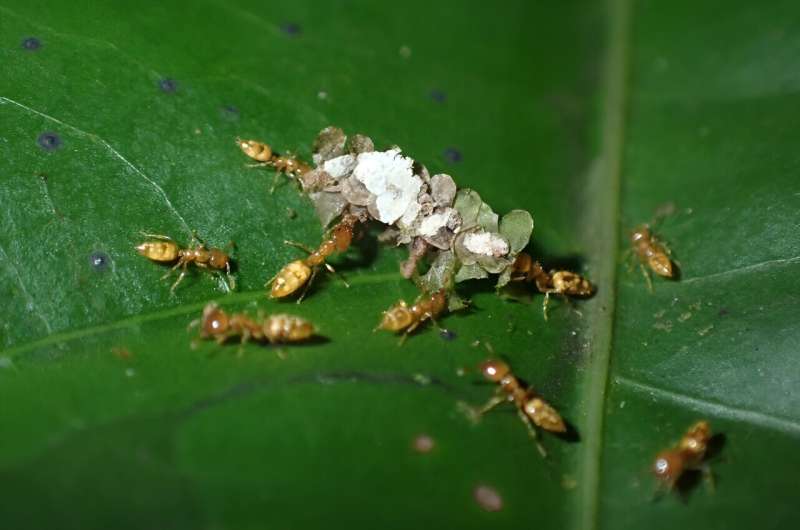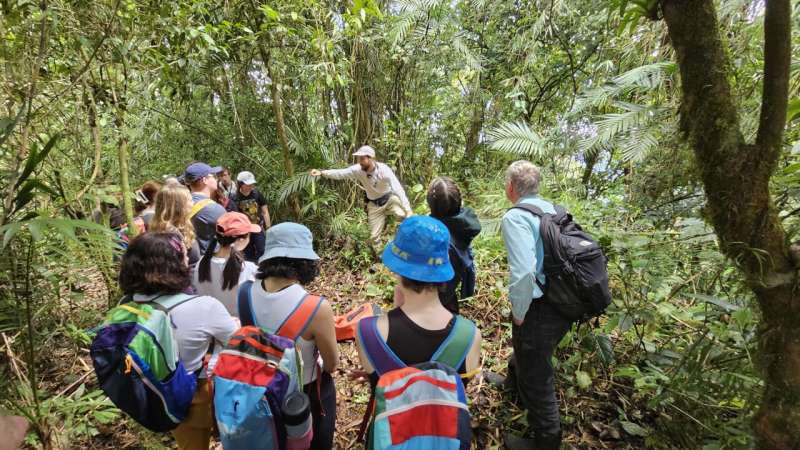
Myrmelachista ants, which dig nesting cavities in living tree stems, keep understory leaves free of debris and pathogens. Credit: Rodolfo Probst, University of Utah
Ants are known for their strict and complex social behaviors. In the tropics, they are also known to form mutual relationships with plants. Some tree species have conspicuous hollow swellings that house ants, who often feed them with special ant food. In return, the ants are pugnacious bodyguards, gathering to aggressively defend the plant from enemies. Scientists have observed these mutual relationships for centuries, but a lingering question is how these intriguing interactions evolved in the first place.
It remains a mystery, but new research led by University of Utah field biologist Rodolfo Probst offers insights that could expand our understanding of ant-plant symbioses.
Published in the Proceedings of the Royal Society BHis research focused on a genus of ants called Myrmelachista. Most Myrmelachista species nest in dead or living stems of plants, without any specialized mutualistic associations. But a group of species from Central America was known to nest only in the living stems of certain species of small understory trees, in a specialized symbiosis similar to other ant-plant mutualisms. These tiny yellow ants bore into stems without harming the host plants and can be found throughout Central America.
Such symbiosis requires complex and novel behaviors and morphology (physical characteristics such as color, shape, and size), and is thought to occur rarely. The Central American specialists were a group of nine species that shared all of these complex characteristics and were only slightly different from each other. It was assumed that a single common ancestor must have developed the symbiosis over a long period of time, and these were very young species that had appeared after the symbiosis had evolved.
Probst made a remarkable discovery. Using DNA sequence data to unravel their evolutionary history, he found that these nine species occur as two groups in different parts of the evolutionary tree. This means that this complex relationship, with all its distinctive features, evolved twice from non-specialist ancestors. What’s more, they also evolved in close proximity to each other and at roughly the same time, about 3 million years ago.
“I wish I could take a time machine and see what happens,” Probst said. “Maybe it’s the ecology or the availability of plants that allowed these friendships to develop in the first place.”

Biologist Rodolfo Probst accompanies University of Utah students on a field research trip to Costa Rica. Credit: University of Utah
He says this is a case of convergent evolution, where different species evolve to become more similar, often because they occupy similar specialized ecological niches. Think of whales and fish. Somehow, these ants evolved the same behavior, what Probst called “evolutionary déjà vu.”
“These two species are so similar that we assumed this mutualism could have evolved once,” Probst said. “What’s most interesting about our paper is that we show that these types of ant-plant friendships evolve multiple times independently. Is this evolutionary déjà vu? It’s as if it’s happening, it could happen again if the right ecological conditions were met.”
His two co-authors are renowned entomologist Jack Longino, better known among university students as The Astonishing Ant Man for his expertise and extensive personal collection of ant specimens kept on campus, and former university School of Biological Sciences postdoctoral researcher Michael Branstetter, now with the U.S. Department of Agriculture’s Insect Pollinator Research Unit at Utah State University.
“The main thing about this paper is the unexpected part. Rodolfo’s work has revealed two independent evolutions of a complex relationship with plants. It suggests that the building blocks of development for very distinctive or complex features are readily available and can evolve rapidly among different groups of species when the conditions are right,” said Longino, a professor of biology at the university who has spent more than four decades studying ants, primarily in tropical regions.
“Morphology alone has never been effective in revealing the relationships between species, the evolutionary spectacle that shows how life diversified on the planet.”
With continued help from undergraduate students in the university’s Science Research Initiative, Probst is seeking to conduct whole-genome sequencing to uncover the genes involved in ant-plant associations, looking “under the hood” of a phenomenon that has intrigued naturalists for centuries.
More information:
Rodolfo S. Probst et al., Evolutionary Déjà vu? A case of convergent evolution in an ant-plant association, Proceedings of the Royal Society B: Biological Sciences (2024). DOI: 10.1098/rspb.2024.1214
Provided by the University of Utah
Quote:Ants and Trees: “Evolutionary Déjà-vu” in the Rainforest (July 18, 2024) retrieved July 19, 2024 from https://phys.org/news/2024-07-ants-trees-evolutionary-dj-vu.html
This document is subject to copyright. Apart from any fair dealing for the purpose of private study or research, no part may be reproduced without written permission. The content is provided for informational purposes only.